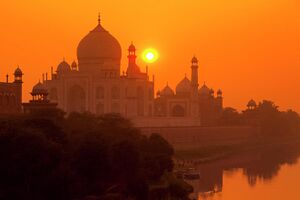India

"Indians are the Italians of Asia and vice versa. Every man in both countries is a singer when he is happy, and every woman is a dancer when she walks to the shop at the corner. For them, food is the music inside the body and music is the food inside the heart."
- – Gregory David Roberts
Bhārat Gaṇarājya, known officially as Republic of India or just India, is a nation and a subcontinent of Asia. Being the world's second most populous country, the seventh largest one and the biggest democracy on the planet, it also possesses culture and history that spans millennia and is currently the only major country where polytheism of old not only survives but thrives in modern day. It is also arguably a sort of a melting pot and a crossroads of Asia - having vast persian and islamic countries to the west and China and others to the east, it naturally was influenced and influenced it's neighbours culturally and religiously (being the land where Buddhism was born after all).
Indian History
The Indian subcontinent has a history spanning some 5000 years which puts it next to long-runner heavyweights like Egypt or China. The history of the place can roughly be divided into a period before the 10th century AD when the various cultures were developing independently and then after the 900s when the islamic invasions happened and India was under the boots of several waves of foreign conquerors before finally gaining it's independence in the decolonization period post WW2. So buckle up as we take a walk through these five millenia.
- Neolithic Period (6000 - 3300 BC) - Human habitation in the area has been confirmed as far back as 33000 BC though it took until around 6000s before permanent habitation and agriculture would develop. The general area west of India near the border with Pakistan and within Pakistan itself is one of the so-called 'cradles of civilization' where early humans could live and develop on easy-mode and so the settlers there inhabited a valley with a system of rivers that provided fertile land for farming while being cradled safely by the mountains at their western border which kept those pesky barbarian bands at bay. This all culminated with the eventual rise of the Indus Valley Civilization.
- Bronze Age (3300 - 1800 BC) - This is where shit gets real and interesting as we proceed from typical stone-banging cavemen to a proper Bronze Age civilization - The Indus Valley Civilization. It was a contemporary of the Egyptians and the Sumerians while being the most expansive of the three and also actively trading with the Sumerians. The cities of this era are notable for the high degree of urban planning and infrastructure (sewers, drainages and waterworks) while also having buildings made of baked brick and being well versed in metallurgy (sans iron). The most notable and important cities are Rakhigarhi, Harappa and the famed Mohenjo-Daro - with an average population of 30-60k EACH, these were the veritable metropolises of Bronze Age India. The civilization started to decline after several earthquakes and general climate shift disrupted the many river that the large cities and conurbations were dependent on, ushering in a familiar pattern of cities getting abandoned as people fucked off to the countryside where there was food and less desparate people to contend with.
- Iron Age (1800 - 200 BC) - This period overlaps with the “Vedic Period,” where Indian culture starts to solidify, particularly with religion, the caste system, and the many different political domains. Hinduism becomes the dominant religion, though it’s chief rival Buddhism also crops up. Towards the end, Alexander’s short-lived invasion of India brings the subcontinent in contact with Europe for the first time, bringing with it Greek influences in the arts and even in Buddhist thought. This is also the era where Sanskrit is first developed, which is one of the oldest languages still in use today.
- Classical Period (200 BC - 650 AD) - Contact with Europe via the Roman Empire continued, as India flourished under the Gupta empire, which would set the standard for how later Indian kingdoms would be run. Major advances take place in architecture, mathematics, medicine, and classical Sanskrit Literature, when Sanskrit is finally written down after Brahamic script was invented.
- Early Medieval Period (650 - 1200) - .
- Late Medieval Period (1200 - 1526) - .
- Early Modern Period (1526 - 1858) - .
- Modern Period (1858 - Now) - You are here. After the Rebellion of 1857, India is placed under direct rule of the British. This does little to stop the establishment of political parties favoring independence. India recieves infrastructure upgrades from the British, and is highly integrated into the British economy, serving admirably in both World Wars. During the Post-colonial period, India gains independence, but is soon wracked by internal division between Muslims and Hindus, resulting in the formation of Pakistan. Post-Britain, India also despises China on account that the China has
wrongdisputed claims on the Himilayas. In spite of this, India has not only one of the highest populations on Earth, but the potential to grow into a great power. They have nukes, a massive amount of untapped human capital, and a strategically important position for commerce and trade. What comes next for them in this period remains to be observed
Indian Culture
Placeholder 3
Indian Religion, Gods and Mythology
Placeholder 4
Indian Magic (Maya)
Placeholder 5
India Analogs in Fantasy
- Quite obviosly, Kingdoms of Ind in Warhammer Fantasy Battle. It is a generally unexplored region, although there are enough hints that we'll get more info on them.